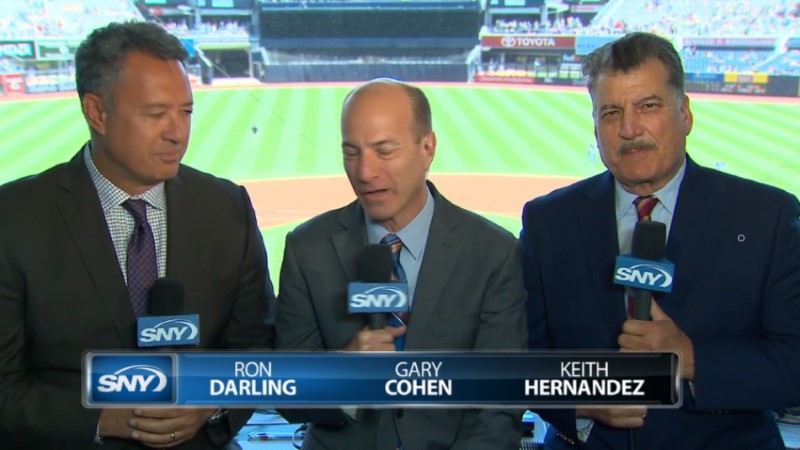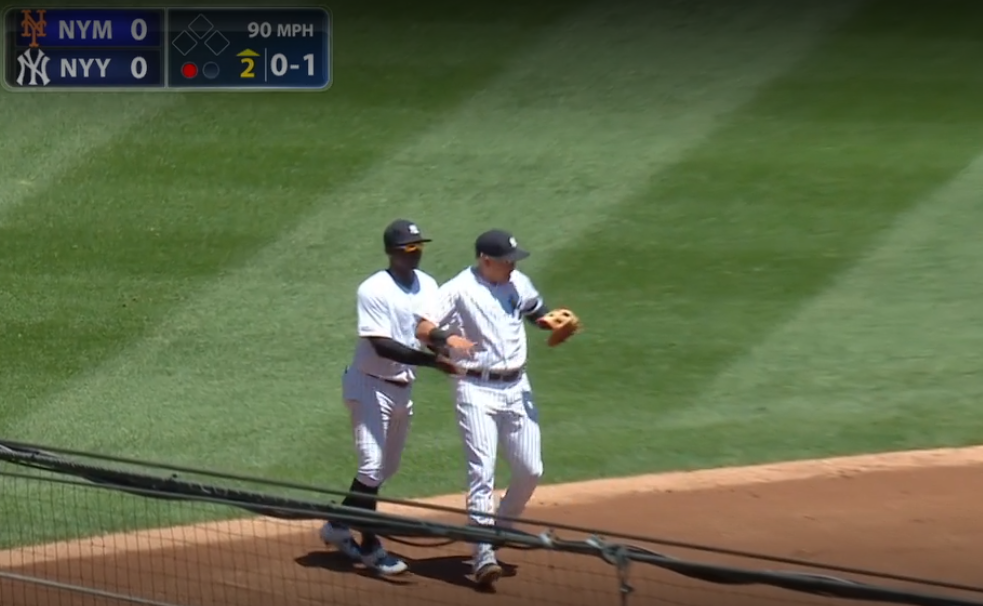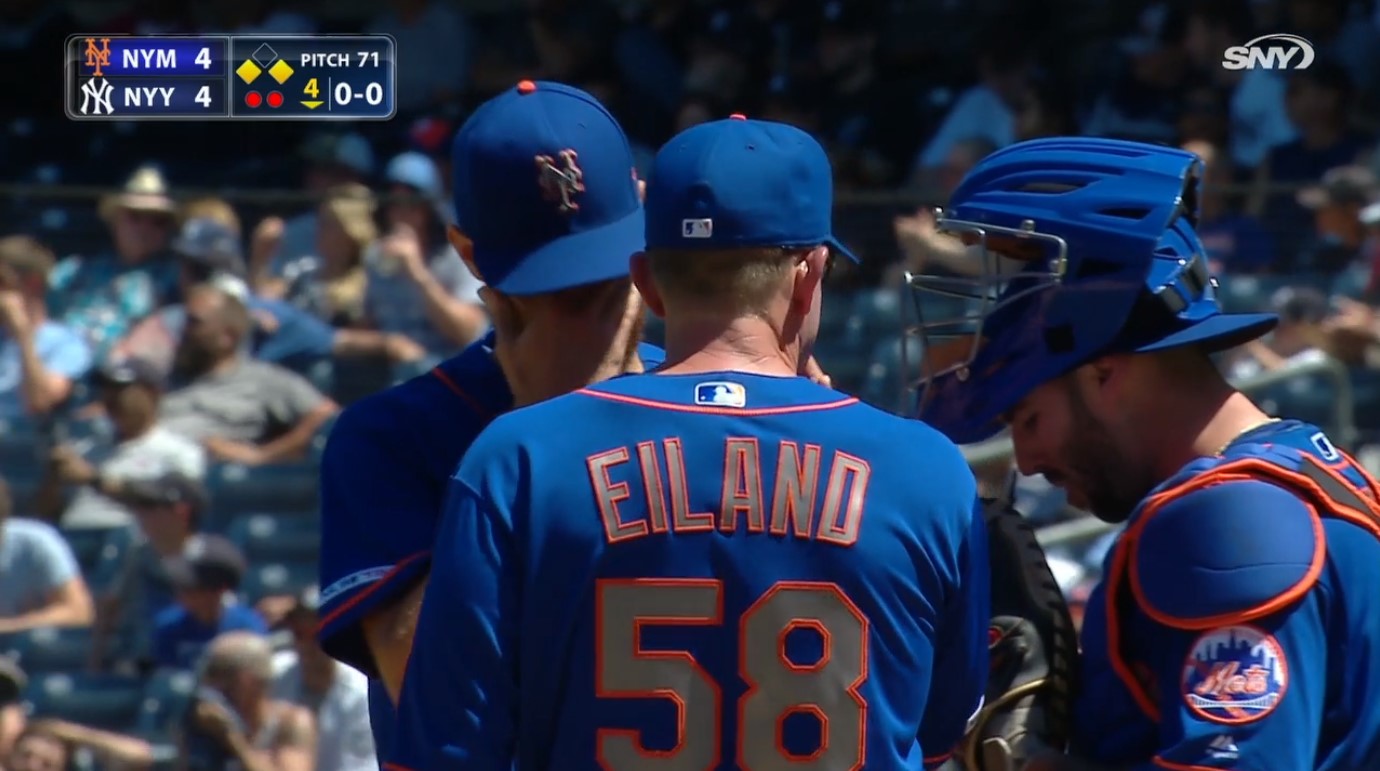Imagining a Socially-Distanced Baseball
Last Friday on Effectively Wild, Meg and Ben (Not me! Curse you, Lindbergh, for your recognizable Ben-ness!) answered a question that several readers had asked. How, the readers wondered, might baseball exist if everyone involved in the game were required to remain at least six feet apart at all times?
It’s a silly question, really; they’re not going to play baseball with social distancing. But a question being silly has never stopped me even when there was baseball to write about, so let’s brainstorm. To figure out what would need to change if baseball wanted to be compliant with the new COVID-19 world we’re living in, I decided to choose a game from last year and watch for what we’d need to change. I picked a random date — June 11, 2019 — and selected the first game available, the first game of a Mets-Yankees doubleheader.
As a recap, Meg and Ben took their best shot at figuring out what might happen. They considered ghost runners or Statcast-estimated speed splits to each base. They considered eliminating the running game entirely. They noted that an automatic strike zone would likely be necessary to remove the umpire from his current position. Additionally, they covered some easier spacing dilemmas — only one reliever up in the bullpen at a time, a mostly-empty dugout with players remaining in the locker room until needed, and automatic reviews that would allow an umpire to stay further from the action.
With those ideas in mind, I started watching my random game. Some of the personal contact would be easy to fix. For example:

Easy — move them farther apart! It might marginally affect announcers’ rapport, but that’s a small price to pay. First problem solved.
A few other pregame issues would also be easy to sort out. Warmups involve a mass of players stretching and throwing near each other; we’d simply get rid of that. There would be no crowd, so that wouldn’t be an issue. In fact, getting to the start of the game seems straightforward. As soon as the game begins, however, there’s something we need to fix:

As Meg and Ben correctly diagnosed, this won’t fly. The catcher needs to be further back, and the umpire further back still. First rule change: an automatic strike zone. I don’t think this is even controversial; the alternative would be an umpire calling pitches from 12 feet behind home plate. Additionally, there’s no framing going on here; a catcher six feet behind the batter can’t present a strike, because the ball won’t be in the right place anymore. Strikes will look too low, low pitches will be in the dirt, and high pitches will look like strikes. Automatic zone it is!
Aside from that, the first at-bat is fine — fine, that is, until after its conclusion. After a sprawling catch in left center, Gardner got a quick high five. That won’t do at all. No more high fives. Easy enough. Those two changes, one major and one minor, account for the entire first inning, an exchange of 1-2-3 affairs. So long as two thirds of plate appearances end in strikeouts and the other third in fly balls, it’s easy!
But then, disaster! Todd Frazier gets jammed, and the result definitely violates Gio Urshela’s personal space:

What are we going to do? This one requires another serious rule change. Meg and Ben discussed banning the shift to account for this, but that doesn’t seem right to me. You can be shifted and still stay six feet apart, and you can also end up near each other in non-shift situations. Instead, let’s insert a new rule that puts the onus on the defender.
We’ve got Statcast cameras to measure everything. If two defenders get within six feet of each other on a play, it’s a dead ball and the runner is safe. Gregorius didn’t need to be there on that play; Urshela had it all the way, there was just no reason to back off. It might take a few reps to get used to it, but hand out errors for getting in other players’ space, and the problem will fix itself quickly.
The very next play requires another big rules change. It’s as generic a play as there is in baseball:
There’s no drama in this one, but there sure is proximity. And so, we have our next major rules change. Rather than try to work out some ghost runner or approximate speed issue, we’re sidestepping the question altogether. Baseball is already considering a wider first base to avoid collisions. Let’s just go completely nuts; there will now be two first bases. One will be the regular base, totally unchanged in its location. The other will be the fielding team’s base. It will be roughly nine feet away from first, at a 45 degree angle behind the bag and in play. To make a force play, a defender can only use the fielder’s base.
Some small adjustments might be necessary to preserve the timing of the game, because the throws will all be a little different now. Maybe first base will have to move a foot farther from home. Overall, though, this seems like the cleanest way to resolve the problem. There’s no need to have the same physical location count for the fielder and the batter in a force play; it’s merely convention.
One knock-on complication: pickoff throws are out, as the runner will now be between the fielder’s base and the pitcher. Given that we’re already outlawing steals, we’ll just draw lines on the field that show the maximum primary and secondary leads. Does this help some players while hurting others? Sure! But that’s unavoidable, so let’s roll with it.
In the bottom of the inning, Gregorius knocks a double off the left field wall. There’s no play at second, but Jeff McNeil still covers the base. So let’s add fielder’s bases to second and third as well. If McNeil wants to cover second, fine. But he can’t get close to Gregorius to do it.
With two outs, we encounter another thing that needs to change:
Yeah, you can’t lick your hands anymore. Not that you really should anyway… but especially not now. Easy fix: every pitcher gets their own spray bottle of water to carry out to the mound. Fingers feeling dry? Protect them without literally sticking your hand into your mouth. It’s more of the same after a run-scoring Kendrys Morales single:
Yeah, again, you can’t touch your face, and this counts. No more kiss/point/kiss/point celebrations. I know this might be difficult for players to internalize, but hey, Dr. Fauci said not to touch your face.
Social distancing really does mean “social.” Next inning, after reaching base on a Gregorius error, Amed Rosario stops to get chatty:

Fielder’s bases already go a long way towards handling this, but to be clear, no! Sean Casey would be very out of place in this reality, because players and base coaches will be strictly required to keep six feet apart. Want to hand over your body armor? You’ll need to set it down in foul territory, walk six feet away, and wait for someone to pick it up.
The next plate appearance features a Gary Sánchez back pick, and yeah, no back picks. They wouldn’t work with the way we have the new bases, and there’s no running game anymore anyway. Aside from that, though, it follows acceptable rules, which brings us to first and third with Juan Lagares at the plate.
Lagares starts by touching his face:

Nope! Outlawed! In any case, this at-bat ends acceptably, with a booted grounder and absolutely no touching. That’s about to change, though, after a McNeil home run:
Oh my. Clearly, all of this has to go away. Meg and Ben’s suggestion of depopulating the dugouts would already mostly cover it, but to really drive the point home, we’ll simply plaster “No Touching!” signs all over the dugout walls. Sadly, that means none of this excellent celebration either:
But that’s the price we pay to play baseball in these beplagued times.
The next few innings don’t feature any plays that fail the distancing test. In fact, the Mets even leave a healthy amount of space between each other when they fail to field bloop singles:
When the ball is out of play, however, we still need another change. McNeil, yet again, gets some physical contact. This time, it’s to check on his arm, which he injured on that very play:

Essential medical procedures only: rub some dirt on it and get back out there. If he really needs it looked at, there’s always the next half-inning; with players banned from dugouts, medical professionals can operate using approved guidelines in the locker room.
Aside from that, there are the normal force plays and infielders getting near each other, but nothing we haven’t already covered; no, Gio Urshela, you can’t celebrate your home run with your teammates, but you’re welcome to dance as much as you want to as long as your hand doesn’t touch your face.
In the bottom of the fourth, there was one obvious violation. Pitching coaches can’t come out to the mound in a world where no one gets near each other:

Maybe they could use walkie-talkies or just speak up? Either way, it’s a quick fix. It might look weird to have the catcher, pitcher, and pitching coach form a triangle around the mound, but it’s safer that way. And don’t even get me started on Wheeler touching his face again — he’s a lost cause at this point.
One issue comes to mind in the sixth. On deck circles will have to change:

The name of the game is to not get other people’s germs, and here’s a pile of implements that everyone on the team puts their grubby hands on. Personal Mota sticks and donuts for everyone!
Remarkably, the first tag attempt on a ball in play doesn’t occur until the bottom of the seventh, when Urshela tries to steal an easy base on a deep fly ball:
That’s a nice throw, but it brings up a tricky and pervasive issue. Tag plays are obvious no-nos. Getting rid of steals and pickoff throws eliminates a lot of tags, but there are still plenty left. My solution: all force plays. It’s not quite that easy, of course, but that’s the gist of it. Here’s how it would work: there’s a line halfway between each base, and between third and home. If a runner is between that line and the base he’s advancing to, a force play is in order. Why that line? That’s how we know the runner is advancing. You don’t want a runner who rounds second by five feet to be out on a force play at third base.
This is a big advantage to the defense, because pretty much every play where a runner evades a tag on an in-time throw would now be an out. But there’s an offensive advantage, too: as part of my rules, runners can freely retreat if a force isn’t in order. Overrun second and realize in time that you’re dead to rights at third? If you stop before the midway line, you’re allowed to retreat to second and the defense can’t do anything about it.
This doesn’t matter on balls caught in the air; that’s a force play, so we can just use the fielder’s bases there. But short of that, you can get out to that 45 foot line with no penalty if you decide to go back. It should lead to some interesting baserunning even without tag plays.
One place where old rules would still hold; I’d make runners hold the base when advancing to encourage sliding or diving. Why? Imagine a wild pitch with these new rules. The catcher can still throw down to second, and the fielder’s base at second will likely be directly behind second towards center field. I don’t want our new rules to result in a ball hitting a baserunner, so forcing them to slide will keep them out of harm’s way.
There would be some fun new wrinkles; an easy play could become a game of stay-six-feet-apart:
Would pitcher Tim Peterson catch that one if the infielders couldn’t get near him to help? Probably. But I’d sure like to find out, and I’d especially love to see an infielder charging, then suddenly dropping to the ground frantically to avoid getting too close to the pitcher.
The main changes to the game are the new bases, the automatic strike zone and associated lack of steals and pickoffs, and the lack of tag plays. These are major changes to the fabric of baseball, but we could work through them if it were the only way to see a baseball game.
But to me, the weird rituals and awkward touches that pervade a baseball game would be a big loss as well, even if they aren’t a part of the rules. Home run parties? Outfield celebration dances? They’d all have to change. Mound visits that look like a crowded subway station? No more. Even the end of the game provides a reminder that lots of baseball is just a bunch of people touching each other’s hands and bodies to show how happy they are:
So could we play baseball without close contact? Sure. But quite frankly, even if I could get used to the new on-field action, baseball would still feel really different to me. Luckily, it won’t come to that; at some point, social distancing will end, and the game will go on mostly unchanged. But I’ll enjoy the high fives and shoulder rubs and dugout celebrations a little more, now that I’ve thought about how much of that goes on in the course of a single game.
Ben is a writer at FanGraphs. He can be found on Bluesky @benclemens.

As one of the folks who asked the question to EW thanks for this article.